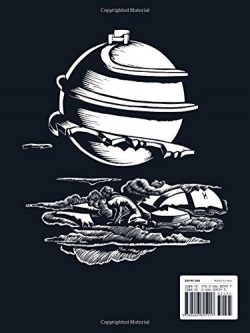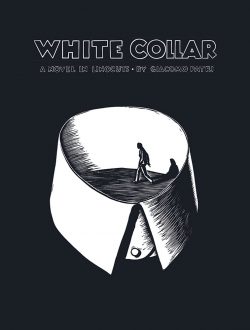

By Giacomo Patri (Dover Comics & Graphic Novels)
ISBN: 978-0-486-80591-7 (HB)
If you regularly access any kind of news in any format or platform, you won’t be at all in doubt or surprised by my calling this book to your attention now. As yet another western leader roils in yet another money/sleaze crisis (I’m not naming them, it will be someone just as guilty by the time you read this and they all have to go!) I’m reminded of the song published a dozen years after White Collar – Carl Sigman & Herb Magidson’s Enjoy Yourself (It’s Later than You Think)…
We tend to think of graphic novels as being a late 20th century phenomenon – and one that had to fight long and hard for legitimacy and a sense of worth – but as this stunning over-sized (286 x 218 mm) two-colour hardback proves, the format and at form was known much earlier in the century… and utilised for the most solemn and serious of purposes.
White Collar was created by jobbing illustrator, artist, educator and activist Giacomo Patri in 1937: encapsulating the tenor of those times as America endured the Great Depression with a view to inspiring his fellow creatives…
Unable to find a publisher for his shocking and controversial pictorial polemic, Patri and his wife Stella self-published the first edition, and happily found publishers for subsequent releases, but not the huge, hungry, underprivileged and angry audience it deserved.
Patri (1898-1978) was born in Italy and raised in the USA. Living in San Francisco from 1916, he overcame the devastating handicap of polio and worked numerous menial jobs until his interest in art carried him through the California School of Fine Arts. Thereafter, he became an illustrator for the San Francisco Examiner, San Francisco Chronicle and other newspapers.
Patri had been interested in social justice and labour issues since the late 1920s, and – once the Depression hit – those beliefs only crystallised. Manual or “blue collar” workers had long organised and unionised to secure bargaining rights and fair wages, and Patri saw that office workers like himself were as in need of such power, autonomy and self-determination. The book was his way of convincing everyone else…
A compelling Introduction by his descendants Tito Patri & Georges Rey offers context, historical background and technical information on the production of linocut art as well as revealing how the creation of such cheap, language-transcending visual tracts became a commonplace method of dissemination.
For context, also included is the story of the artist/author’s troubles during the repressive, red-baiting Joe McCarthy years and beyond…
Following the salutary lesson is the Original Introduction by fellow artistic agitator and creative pioneer Rockwell Kent before Patri senior’s endeavours to enlighten his fellow illustrators and clerical staff begins. Unfolding over 128 bold images of stark metaphor and rousing symbology, the astounding visual record offers a clarion call to arms, tracing one family’s struggle between 1929 and 1933. It’s all delivered with beguiling subtlety and shocking, silent potency in plates of deepest black or startling orange.
This ‘Novel in Linocuts by Tito Patri’ is dedicated “To the great progressive Labor Movement, the Congress of Industrial Organisations” and remained both obscure and controversial for years. That wasn’t so much for its left leaning content as its uncompromising depiction of the abortion Catch-22: a truly heart-rending depiction of a family too poor to survive another mouth to feed but without the cash to pay a back street quack for an [illegal] termination. Maybe this book should be handed out free all over Middle America and the Christian South?
The world has moved on from replicating those dark days of Haves, Have-Nots and Why-Should-I-Cares? These days those with power actual police how The Poor and Godless use the bodies and wits they’ve generously been permitted. They can thus be guided into promoting National Growth and Prosperity… Thankfully this magnificent rediscovery remains a stirring, evocative and still movingly inspirational riposte, closing with a final assessment and plea from cartoonist, designer and contemporary activist Peter Kuper in his trenchant Afterword accompanying the Original Epilogue by John L. Lewis…
Inventive, ferocious in its dramatic effects, instantly engaging and enraging, this is a book every callous, indifferent “I’m All Right” Jackass and greedy, smug “Why Should I Pay For Your…” social misanthrope needs to see… or be struck repeatedly with.

© 1987 by Tamara Rey Patri. Introduction © 2016 by Tito Patri. Afterword © 2016 by Peter Kuper. All rights reserved.
